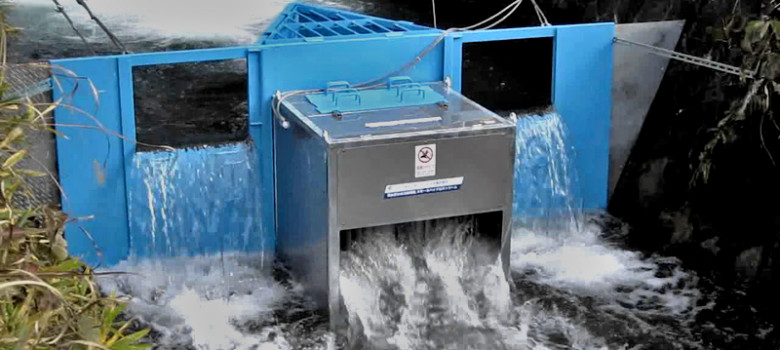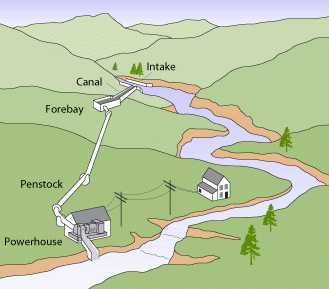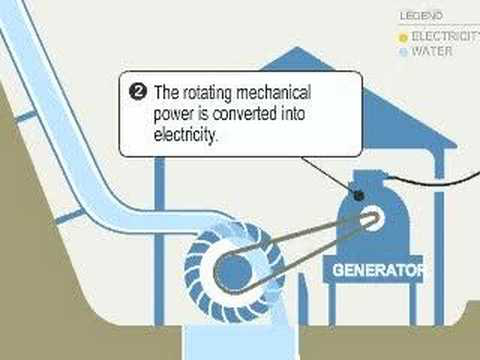
Contents
- 1 Overview of Micro Hydro Power System
- 2 What Do You Need To Set Up Micro Hydro Power System?
- 3 What Are the Components of a Micro Hydro Power System
- 4 How a Micro Hydro electric Power System Works: Step-By-Step
- 5 Choosing the Location of a DIY Micro Hydro Power
- 6 Water Head and Water Flow of the Micro Hydro Power System
- 7 How to measure the head of a micro hydropower site?
- 8 Measuring the Water Flow of a Micro hydro site
- 9 The Cost of a Micro Hydropower System
- 10 Permits and Water Rights for Microhydropower System
Overview of Micro Hydro Power System
Micro hydro is a kind of hydroelectric power that ordinarily delivers from 5 kW to 100 kW of power utilizing the regular progression of water.
The electric power systems that are rated below 5 kW are called pico hydro.
These installations can give the capacity to run a home or small community that is off the grid.
You can even connect the micro hydropower to the main electricity grid, especially where net metering is offered. This can be an income-generation venture.
There are a considerable lot of these installations around the globe, especially in rural areas as they can give a practical and reliable supply of electricity without the need for fuel.
Micro hydropower systems supplement sunlight based PV power frameworks, especially in areas that have the ideal water bodies such as streams.
Micro hydro is often achieved in conjunction with a pelton wheel for high head, low stream water supply.
The micro hydroelectric is frequently only a small dammed pool, at the highest point of a waterfall, with a few hundred feet of funnel prompting a little generator lodging.
In low head locales, by and large water wheels and Archimedes screws are utilized.
What Do You Need To Set Up Micro Hydro Power System?
The most basic requirement for setting up a micro hydro power system is flowing water.
Is there a river or stream that is flowing through your premises? If the answer is yes, then you should consider setting up this system.
But, should the river be too large so as to generate enough energy?
Since it is micro hydropower, the water source does not have to be too large or too expansive.
A micro hydropower system is capable of generating energy that can run your home, farm and even a small factory.
Its energy production capacity can range between 10 kilowatts to 100 kilowatts.
Another thing that you need is a turbine a pump and a water wheel. All these components are responsible for transforming the energy that is stored in the flowing water into electrical energy.
What Are the Components of a Micro Hydro Power System
The components of a micro hydro power system include;
-Intake tunnel
-The canal
-Forebay tank
-Penstock pipe
-Powerhouse
-Dam
-Weir
The intake system
The intake system is strategically located along the stream to accept the water that will be used for the micro hydropower generator.
This position should filter off the debris while at the same time, allow a build-up of the water pressure.
-Forebay: This is a basin-like structure that is found right before the passage to the penstock. It could be a straightforward unearthed segment or pond or made of fortified cement.
It perhaps or may not exist and fills in as a settling basin for sand and sediment which can damage the blades turbine.
It can also serve as a temporary storage system for the micro hydro power.
-Spillway: This component is designed to get rid of the excess water that has accumulated in the forebay. This water should be redirected with the utmost precision so as to prevent cases of erosion.
-Power conduit: This is an excavated canal that is reinforced with concrete, stone, or would metal sheet. Most force channels have enough slant or slope to allow easy flow of water. A pipe can be used to control the pressure of the water. It creates a connection between the intake and forebay.
-Penstock: This is a pipe that passes on high-pressure water constrained to the turbine. Wire mesh of sensible quality ought to be placed before the penstock to filter off agitated sand. It tends to be introduced above/underneath the ground and connected with the expansion joints. Entryways and valves can be consolidated toward the end of the penstock.
-Powerhouse: This is usually regarded as the engine house of the micro hydro power system. It encloses the electrical and mechanical equipment that is responsible for power generation.
Some of the components that are found in the powerhouse include;
1. Turbine: This is usually referred to s the waterwheel or pump. Its function is to transform the kinetic energy in the flowing water into potential energy.
2. Generator/alternator: Transforms rotational energy into electrical energy.
3. Regulator: Controls the performance and operation of the generator.
4. Wiring: Conveys electricity from the generator to the mains.
-Dam or Weir: The dam of a hydro power system is designed to channel water into the intake system. Dams or weirs are usually used as water reservoirs. They ensure that the water will always be there when needed.
A dam is also constructed to increase the head hence the pressure of the water that will be used for turning the turbines.
However, since a micro hydro power system uses runoff water, there is no need for constructing a dam.
The small volume of water is capable of generating the needed electricity.
In most cases, turbines and generators are sold as a package or a single unit.
If you are planning to build a DIY micro hydronpower system, then you need to be more careful when matching the generator and turbine. The horsepower and the rotation speed of these two critical components should match.
Also, most micro hydro power systems have inverters whose function is to convert the direct current (DC) into the alternating current (AC).
This is done because most electric appliances don’t run on DC. However, you can choose to operate with DC if your appliances allow.
A micro hydropower system can be grid-connected or it can operate as an independent entity. The grid connection will be ideal if there is a metering component.
Once all these components are in place, then you can sit back and start utilizing your micro hydro electric power system.

How a Micro Hydro electric Power System Works: Step-By-Step
How do the above components of a micro hydro power system work together to generate electricity?
The working principle of a micro hydro electric power generator is pretty simple.
Once the site for the hydro power system has been chosen, and all the components installed, the first step of electricity generation entails the turbine capturing the water.
The flowing water will spin the turbine converting the kinetic energy to rotational energy. This rotational energy is then transferred to the powerhouse, where it will be converted to electrical energy.
From the powerhouse, the generated electricity will be transferred to the required destinations.
And that is it! Nothing is complicated when it comes to micro hydro power generation.
The only question that you may have is, how much energy can the system generate?
Well, here there are several factors that come into play. Apart from the nature or size of the stream, the micro hydro power turbine will also have a direct impact on the output energy of a hydro power.
The specifications of the power generator will, of course, influence the whole process.
You can consult a micro hydro power systems manufacturer for further information with regards to the energy output of these systems.
Choosing the Location of a DIY Micro Hydro Power

Is there are river or a stream flowing near the premises? If the answer is yes, then you are the right candidate for the micro hydroelectric systems.
All micro hydro power plants need to have close proximity to a water source.
However, that is not all. You still need to look at other factors when choosing the exact location of your micro hydro power for off grid houses.
Some of the factors that will guide you in choosing the location include the desired power output, the cost of installing and running the system and even the local laws that give guidance with regards to micro hydro power installation.
Water Head and Water Flow of the Micro Hydro Power System
Apart from all the other reasons, there are two critical factors that will determine whether a micro hydro power system will work for you or not.
These are the head and the flow of a hydro power system.
“Head” is a term that I used to refer to the vertical distance that the water falls.
On the other hand, “Flow” refers to the quantity of water that will fall on the turbine.
Once you have the values of both the head and the flow, you will be able to calculate the estimated power of a micro hydro power system.
You will only need to multiply the net value of the head by the value of the flow(gallons per minute). Divide the results with 10 and the value that you will obtain well be in watts.
In simpler words, we are saying net head(feet)× flow (gpm)/10
How to measure the head of a micro hydropower site?
As we have already defined, the head is the vertical distance through which the water falls.
The value of the head is measured in meters, feets or even units of pressure.
You can also measure the head by simply using the value of pipe in which the water flow.
This is usually the distance from the top-end of the penstock to the point at which the water is discharged from the turbine.
A micro hydropower site can either be a high head or a low head. The value of the head is what will determine the category under which the site falls.
Any site that is less than 10 feet (3 meters) can be categorized as a low head micro hydro site. They are ideal for small scale electricity generation.
High head micro hydro sites are ideal when you need to generate more electrical energy.
If you have time, you can measure the head manually. The best way is to check on the geology of your area.
Measuring the Water Flow of a Micro hydro site
After measuring the head, you can proceed to measure the quantity of water that is falling from a proposed micro hydro site.
The value of the flow can be in terms of liters per second or cubic per second.
Obtaining data from the local geological office is just one of the ways of knowing the flow.
Alternatively, you can employ a geological engineer to carry out the task.
The Cost of a Micro Hydropower System
Is microhydropower a viable project that you can undertake?
Before doing the installation, it is pretty obvious that you would like to know whether it makes sense to install this hydroelectric generating system.
There are many ways of looking at the cost of this project. For instance, if you are spending too much money on electricity bills yet there I a river flowing nearby, why not venture into the project?
You can buy a small micro hydro power turbine that will not cost you too much money to install and use.
If you are running a business, you can compare the energy bills vs the returns. Will the micro hydroelectric system yield more ROI?
Doing micro hydro power calculations will also help you to know the economical factor of this project.
Permits and Water Rights for Microhydropower System
A microhydropower system is to be done on a natural resource. Even though the process will not have a huge impact on the river, it will still attract the attention of the authorities.
For this reason, you need to seek permission from all the relevant authorities. Get the permits and other certifications that are required for the project.
This way you will be able to save yourself from being frustrated in the near future.
In conclusion, I hope that this information is enough to help you go ahead with your micro hydro power plants installation. In case of anything, feel free to ask experts in the field.


